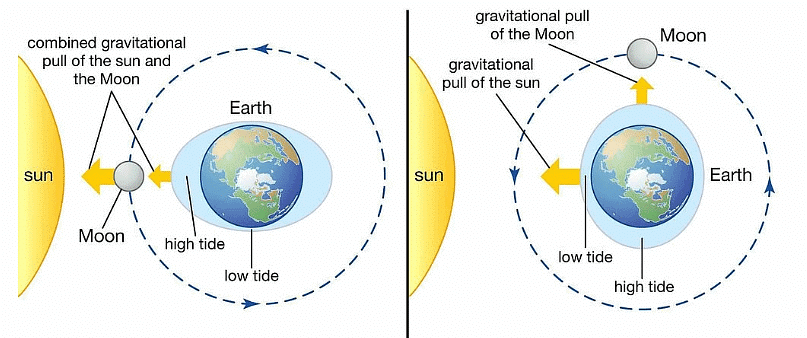Class 7 Exam > Class 7 Notes > Year 7 Physics (Cambridge) > Tides
Tides | Year 7 Physics (Cambridge) - Class 7 PDF Download
What Causes Tides?
- If you've ever spent a day at the beach, you've likely noticed the ocean water is constantly moving. Waves cause the ocean to move all day long, and tides cause the ocean to rise and fall twice each day.
- The highest point of the water is called high tide, and the lowest point is called low tide. Plants, animals, and humans living near the ocean rely on this predictable rising and falling of the ocean each day.

The Role of the Moon
- The moon is the main cause of tides in Earth's oceans. Both the moon and Earth have gravity, the force by which a planet or other body draws objects toward its center.
- Gravity keeps all the planets in orbit around the sun and keeps the moon in orbit around Earth. Although the moon's gravity is weaker than Earth's, it is still significant because the moon is so close to us.
How Tidal Forces Work
- As the moon's gravity pulls on Earth's water, the water bulges in the direction of the moon. This bulge is due to something called the tidal force. Because of the tidal force, Earth's water on the side of the moon always wants to bulge out toward the moon.
- This bulge is what we call a high tide. As your part of the Earth rotates into this bulge of water, you experience a high tide.
Explaining the Second High Tide
- When the moon's gravity pulls on one side of Earth, it creates a tidal bulge toward the moon. However, the tidal force affects the entire planet, not just one side.
- The total effect of the tidal force is that Earth experiences a squeeze, causing the water to bulge on two sides. These two bulges explain why in one day there are two high tides. Earth's surface rotates through each of the bulges once a day.
Climate Change and Tides
- As Earth's climate warms and oceans rise, high tides are becoming higher, sometimes leading to flooding in coastal communities.
- High-tide flooding occurs when tides are approximately 2 feet above the average high tide, causing ocean water to spill onto streets or bubble up from storm drains.
Question for TidesTry yourself: What is the main cause of tides in Earth's oceans?View Solution
Studying High-Tide Floods
- Scientists use information from many sources, including NOAA’s GOES-R series weather satellites, to study high-tide floods.
- Coastal communities can use this information to better plan for the effects of rising tides in the future.
Examples
- Example of High Tide: When you are at the beach and the water level rises to its highest point, this is high tide. This usually happens twice a day due to the moon's gravitational pull.
- Example of Low Tide: Low tide occurs when the water level falls to its lowest point. This also happens twice a day, halfway between the high tides.
- Example of Tidal Bulge: Imagine a rubber band around a ball. If you pinch the rubber band on two sides, those pinched areas represent the tidal bulges caused by the moon's gravity.
The document Tides | Year 7 Physics (Cambridge) - Class 7 is a part of the Class 7 Course Year 7 Physics (Cambridge).
All you need of Class 7 at this link: Class 7
|
14 videos|31 docs|9 tests
|
FAQs on Tides - Year 7 Physics (Cambridge) - Class 7
| 1. What is the main cause of tides? |  |
Ans. Tides are primarily caused by the gravitational pull of the moon and the sun on the Earth's water.
| 2. How do tidal forces work? |  |
Ans. Tidal forces work by the gravitational attraction between the Earth and the moon, causing the water on Earth to bulge towards the moon, creating high tides.
| 3. Why do we experience two high tides and two low tides each day? |  |
Ans. We experience two high tides and two low tides each day due to the rotation of the Earth and the gravitational pull of the moon as well as the sun.
| 4. How do tides affect coastal ecosystems? |  |
Ans. Tides can influence the distribution of nutrients and organisms in coastal ecosystems, as well as impact erosion and sedimentation processes along coastlines.
| 5. How can tides be predicted? |  |
Ans. Tides can be predicted using mathematical models that take into account the position of the moon and the sun, as well as the geography of the coastline.
Related Searches
















